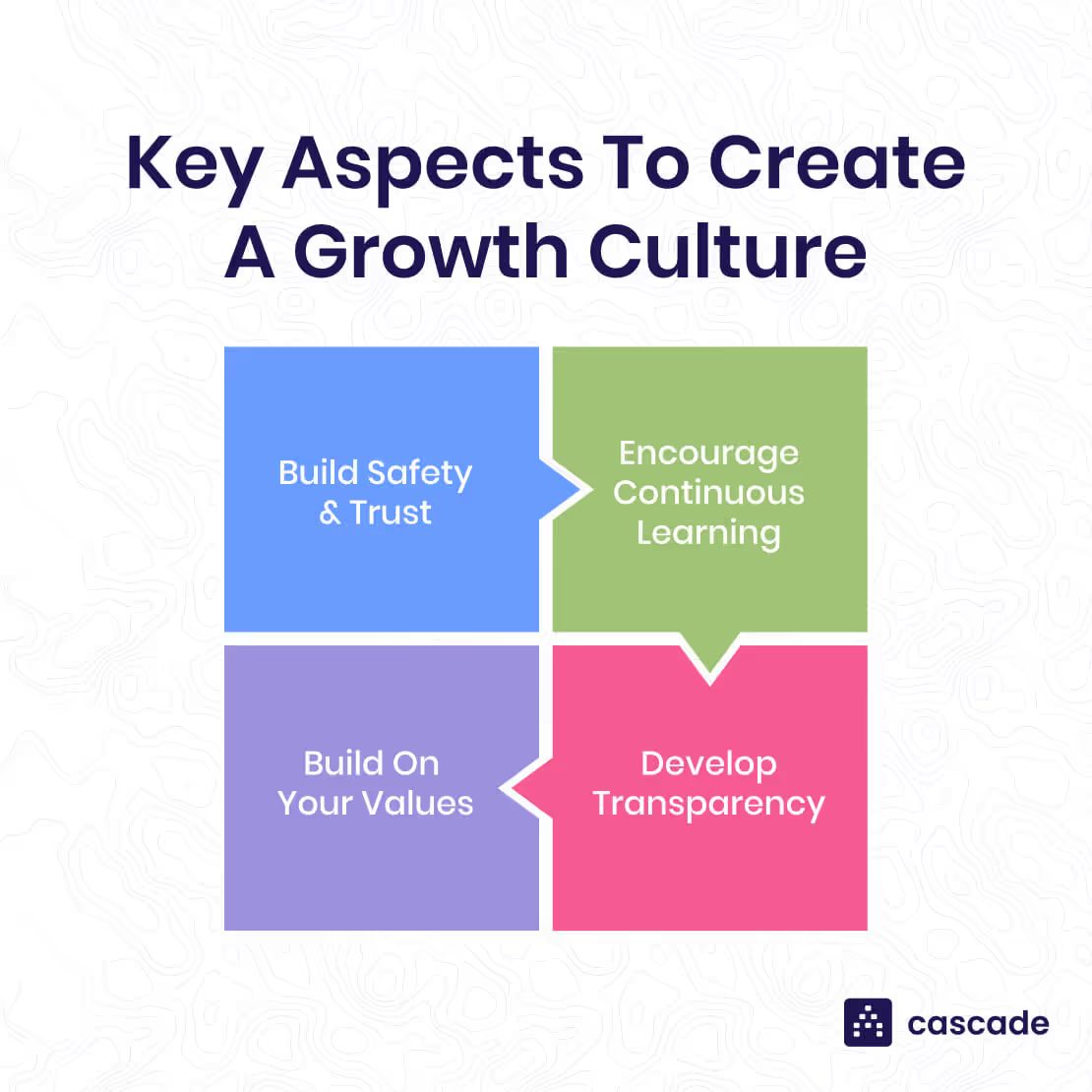In a world where the relentless pursuit of high performance often breeds fear, anxiety, and a stifling work environment, it's time to shift our focus toward prioritizing a growth culture.
As Tony Schwartz shares in his Harvard Business Review article “Create a Growth Culture, Not a Performance-Obsessed One”:
“A performance-driven culture often exacerbates people’s fears by creating up a zero-sum game in which people are either succeeding or failing and winners quickly get weeded out from losers.”
But building high-performing teams isn't about pushing harder or scrutinizing every metric. It’s about fostering a growth mindset that nurtures an atmosphere where individuals can thrive, innovate, and learn without the looming specter of failure.
In fact, promoting a culture where employees feel safe and are allowed to learn through experimentation positively influences business performance:
According to a Gallup survey, organizations that value their people and prioritize increasing employee engagement enjoy 81% lower absenteeism and 58% fewer safety incidents.
In this article, we’ll explore four key aspects of creating a culture of growth that drives results—without the negative consequences of a performance-obsessed one—and provide real-world examples from successful companies.

1. Build Safety & Trust Organization-wide
Create a safe environment
Safety isn't just about physical well-being; it extends to psychological safety.
A growth culture can't thrive when fear dominates the workplace. Fear holds people back from taking calculated risks or stepping out of their comfort zones.
When a sense of safety is absent, people shift their priorities to self-protection. They hide their errors to dodge consequences or job insecurity, preventing the organization from learning from mistakes and avoiding future pitfalls.
The organization's progress becomes irrelevant in their daily work lives, and people try to get on with their work, stay under the radar, and not call attention to themselves.
💡The lack of psychological safety is detrimental to the organizational culture.
Cultivate trust from day one
In a growth culture, trust is non-negotiable.
It's a two-way street that starts with leadership and extends across the entire organization:
- Leaders set the tone by nurturing a safe environment where their team members feel comfortable sharing challenges and receiving support.
- Team members contribute to this culture of trust by offering their support, not only laterally but also upward, with a simple question: "How can I help?"
The flow of trust in both directions, up and down the organizational hierarchy, is a critical catalyst for transparency.
💡At Cascade, we live by the mantra that "Trust is given, not earned."
Lead by example
Leaders have a vital role in shaping an environment where everyone feels at ease making mistakes and taking calculated risks.
One effective way to achieve this is for leadership—including the C-Suite—to openly acknowledge their own failures. When leaders and role models admit their vulnerabilities, they encourage others to do the same.
💡 Hearing their leader say, "I don't know," or "I need help with this. What are your ideas?" or "This is on me. I made a mistake," reassures people that these behaviors are not condemned.
Embrace failure to learn & adapt
To nurture innovation, shift your perspective on failure. Instead of dwelling on past mistakes, focus on learning from them. Even if a mistake is costly, treat it as a valuable lesson.
In a growth-oriented culture, leadership doesn't just tolerate failure but actively encourages repeated attempts until the goal is achieved. To enable innovation, go beyond permitting failure; the real value of a growth culture lies in promoting continuous experimentation and resourcefulness.
💡Treat mistakes as lessons to ignite innovation.
Success Story
Costco is renowned for its unique culture and high employee retention, with competitive salaries, uncommon industry benefits, and elevated job satisfaction.
Lesser known is the company's consistent financial stability since going public in 1986. It has continuously outperformed the S&P average since 2010.
James Sinegal, the co-founder of Costco, and his successor, Craig Jelinek, firmly believe in long-term investment through employee well-being. With a consistent turnover rate below 10%, it's clear they've made the right call.
2. Encourage Continuous Learning
Empower your people
Fear often leads people to lean heavily on rules for safety.
Rules have their place during standard operations, but they become less relevant in moments of crisis or unexpected situations. In those instances, you want your team to have the freedom to identify exceptions and act in the best interests of their company and its customers.
💡 Leaders should trust their team to know when it's appropriate to bend or break the rules.
Encourage experimentation
Encouraging experimentation within your team is the key to fostering innovation and growth.
Here are actionable tips to enable experimentation:
- Allocate time & resources: Provide your team with dedicated "innovation time" or allocate a portion of the budget for experimental projects.
- Create a safe space: Foster an environment where calculated risks are not only allowed but actively encouraged.
- Recognize & celebrate: Acknowledge and celebrate both the successes and the lessons learned from experiments.
- Encourage sharing: Promote open communication and the sharing of findings within the team to facilitate continuous improvement and idea refinement.
💡 Encourage a culture of continuous learning by viewing every experiment, whether successful or not, as an opportunity for growth and development.
Encourage decision-making
Encouraging decision-making isn't just about empowering your team; it's about rethinking your organization's structure.
Traditionally, companies focus on efficiently passing information from front-line employees to decision-makers to ensure the right people have the data they need for informed choices.
The problem with this approach is that many situations faced by front-line employees are time-sensitive. By the time information reaches decision-makers and decisions come back, it's often too late.
Consider this: your teams make decisions every day. So, what if we change things up?
💡 Instead of just relaying information, provide training and empower your team to make decisions, and take charge of situations, problems, and solutions.
📚 Recommended read: Top-Down vs Bottom-Up Leadership: A Comprehensive Guide
Success Story
Bob Chapman changed the trajectory of the HayssenSandiacre company by changing its culture. Though not big or fancy, the changes were very powerful at communicating one thing only to its people: that management trusts them.
The bells regulating break times and work returns disappeared. Time clocks for punching in and out were eliminated. And the security cages around spare parts were taken down.
These continual signals of trust ignited a remarkable shift in the company's culture. This cultural shift also ushered in a revenue turnaround, nearly doubling it over time.
3. Develop Transparency
Strive for full visibility
In the journey toward organizational growth, clear visibility is crucial for informed decision-making, continuous improvement, and innovation. Centralized observability serves as a powerful tool, offering a comprehensive overview of operations and enabling real-time monitoring and data-driven decision-making.
Striving for complete visibility involves creating an environment where information flows freely, encouraging open communication, and ensuring all team members have access to the data they need.
💡Striking a balance between bottom-up and top-down approaches ensures that transparency serves both individual needs and overarching organizational goals.
Implement continuous feedback
Continuous feedback is another important tool to build transparency but also guide improvement, refine decisions, and spark innovation.
Cultivating a culture of ongoing feedback ensures that every voice matters and contributes not just to the organization's growth, but also to the personal growth of its employees.
💡 Establish a feedback loop that embraces input from all levels of the organization, from frontline employees to leadership.
Build cross-functional collaboration
Cross-functional collaboration isn't just about teams working together; it's about breaking down silos, fostering understanding, and striving toward common goals. When teams seamlessly collaborate across functions, they align their efforts, share their expertise, and enhance transparency.
The result? A significant boost in efficiency and effectiveness. Projects move forward faster, and decisions are made with a comprehensive view of the organization's needs and capabilities.
💡 Promote cross-functional collaboration by actively supporting inter-departmental teamwork, aligning goals, and providing the necessary tools and resources for seamless cooperation.
Success Story
In 2006, when Allan Mulally took the reins as Ford's CEO, he encountered a company on the brink of bankruptcy, drowning in a culture of fear. Transparency was a rare commodity; employees were reluctant to voice concerns for fear of repercussions.
Mulally's game-changing move involved recognizing and rewarding a senior manager who courageously raised a red flag, rather than punishing them.
This approach gradually nurtured trust within the team, leading senior management to openly address crucial issues. The resulting transparency united the team, enabling them to provide vital support that ultimately saved the company.
4. Build On Your Values
Cultivate your desired values
Organizational values are foundational for a company's culture and success. They guide behaviors, shape interactions, decisions, and contributions, and provide an ethical and moral framework.
There are two parts to achieving a values-based culture:
- Reward aligned behaviors: Recognize those exemplifying your desired values, reinforcing that performance isn't the sole focus.
- Condemn contradictory behaviors: Address opposing actions promptly to show a strong commitment to your organization's values.
💡Reward the behaviors you advocate and condemn the opposites fast.
Locate your cultural stars
Every organization has individuals who embody the company's values in a remarkable way.
Identify these employees, not necessarily the highest performers, but those who genuinely embrace the company's values. They are your cultural stars, the ones you want others to emulate. These ambassadors set the standard for acceptable behaviors within the organization.
💡 Leadership should recognize these individuals and showcase their behaviors, creating role models for others to emulate.
Success Story
Patagonia, the American clothing company, demonstrates a commitment to its core values that extends well beyond the boundaries of corporate responsibility. One of these values is "Cause no unnecessary harm."
In an impressive display of integrity, Patagonia uncovered substantial violations within its second-tier supply chain. Taking proactive measures, they dedicated themselves to improving the conditions of their suppliers.
This unwavering dedication to their values in external affairs is a strong indicator of how Patagonia treats its employees with the same level of integrity and commitment.
Elevate Your Growth Culture With Cascade 🚀
Cascade is your key partner for building and fostering a growth culture.
As the world’s #1 strategy execution platform, Cascade helps businesses connect siloed metrics, initiatives, and investments with their realized performance.
Our platform enhances your organization's decision-making and ensures full visibility and cross-functional collaboration:
- Centralized business observability: Gain a comprehensive view of your organization's operations by real-time data monitoring, empowering data-driven decision-making.
- Full visibility for organizational alignment: Foster a culture of transparency where information flows freely, ensuring all team members have access to the data they need, enabling adaptability, innovation, and growth.
- Effective cross-functional collaboration: Achieve seamless inter-departmental teamwork, aligning efforts, sharing expertise, and enhancing transparency, resulting in increased efficiency and effectiveness.
Discover the power of Cascade! Sign up today for free or book a guided 1:1 product tour with one of Cascade’s in-house strategy execution experts.





.png)
.jpg)
.jpg)
%20(1)%20(1)%20(1)%20(1)%20(1).png)



